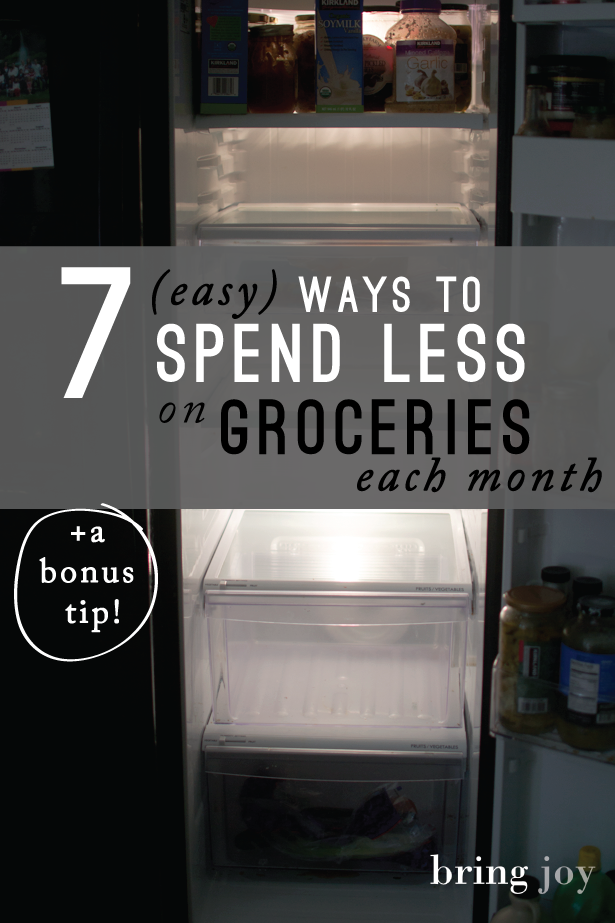**This post contains affiliate links.**
What’s the hardest spending category for you to stay on budget every month?
For us, hands down, it’s groceries.
I mentioned awhile back, we revamped our budget to reflect our current reality. Not the reality we want, but the reality that actually is.
Part of that was getting honest about how much we spend on groceries each month. As our family has expanded (now a family of 7!), & my kids have grown (along with their appetites), Joseph & I have realized that hey, $500 a month on groceries is not only not realistic, but it’s just not doable in light of our dietary preferences & needs.
I don’t buy all organic, but I do want some organic foods. We eat a lot of rice & beans made from scratch (which saves a ton of money, don’t get me wrong), but since we’re in this get-out-of-debt process for awhile, it’s important for us to have a sustainable, doable budget. Not too strict, but not too liberal either.
Since we decided on $900 a month (which includes household & toiletry items), I feel like a weight has been lifted. Before, I had budgeted somewhere around $600 and every month I was defeated because I overspent by several hundred dollars. Pretty silly.
Do you ever do that?
Create crazy unrealistic, ambitious goals that leave you disappointed because they’re not quite grounded in reality? Yup, I’m guilty as charged.
Other than setting a realistic, sustainable budget that will meet your needs, it’s important to find ways to save on money, & time. No matter if you’re in get out debt mode or not, everyone wants to save money, right? Right.
So here are some ways (that we’ve found) to do that.
7 ways to save on groceries each month
↓↓
1. Go grocery shopping 2-3 times a month.
I know this may seem crazy to those of you who go several times a week. But let me explain the reasoning here.With our 5th child, I’ve realized that I absolutely had to streamline my life & routine if I was going to survive. Part of that streamlining process was to set specific days of the month/week for grocery shopping, & stick to it (this is also one of the principles of time management in Amy Andrew’s Tell Your Time).
Not only does this save time & gas, but it saves money as well. Think about it, you’re more likely to spend more with each trip to the grocery store in any given month. I always have a list, but I know that inevitably, I always pick up an extra thing or two that is not on my list.
Since I only grocery shop a few times a month, no problem. But if you’re going 6, 7, 8 or more times in a month, unless you have uber self-control (which I’m sure some of you do, just not me), you’re likely to spend more on unnecessary purchases.
I do a big Costco trip at the first of the month. Then at the middle & towards the end of the month I do trip to a regular grocery store, but only to fill up on perishable groceries (I buy all pantry items at the beginning of the month). I love shopping at Costco, but fortunately, it’s about 25-30 minutes away, so I’m not tempted to do more than one, maybe two shopping trips a month.
2. Shop online.
A lot of places offer free shipping. Of course there’s Amazon, which if you have a Prime membership (you can try out a FREE 30-day trial HERE, you get free 2-day shipping on many items, & they recently added a benefit called Prime Pantry, where you can order up to 45 pounds of bulky grocery items per shipment (that don’t qualify for free shipping) & pay just $5.99 in shipping per order (the convenience of not going to the grocery store, plus saving on gas is totally worth it to me!).
If I can’t find it at Costco or Amazon, I shop Vitacost, which offers free shipping on orders over $49. Vitacost is a discount online retailer that specializes in carrying a ton of alternative, natural, organic, & vegan grocery items & supplements. I’ve ordered nutritional yeast, energ-G egg replacer, TVP, & stevia extract, among other items that are harder to find (or much more expensive) at a regular grocery store.
The few herbs & supplements that we use I order from HerbsPro which offers great discounts & free shipping (on orders over a certain amount) on a slew of natural/alternative products. I order some Dr. Christopher herbals–like his kid-e-mune extract, his kid-e-mins formula, as well as one of my prenatals.
3. Let your fridge go bare, then “shop” your freezer & pantry before going shopping.
Set your shopping days & try to stick to them as much as possible. Last month I set a goal to stick to our set shopping days. This required planning & self-restraint, but I knew I was successful when we were down to the last week of the month & my fridge was pretty bare (condiments aside).
I keep a well stocked pantry & freezer (you know you can freeze most foods) so it wasn’t hard to figure out meals based on what we had between the two. Sure, I missed having lettuce & other fresh foods, but we always have plenty of frozen fruits & veggies, enough to get by for more than a few days. And in the end, we stayed on budget & ate some pretty decent meals without making those extra trips to the grocery store.
4. Make a (realistic) grocery budget, & stick to it.
If you are consistently going over your grocery budget one of two things may be happening.
First, you may be setting your budget too low. Be honest about your income & other expenses, your dietary needs & preferences as well as your family size & readjust your budget as necessary.
Second, you may be overspending on silly stuff. I find that shopping with Joseph keeps me from getting too many extras that we don’t really need (hello! Costco.). Also, creating a shopping list & sticking (mostly) to it also helps me stay within budget.
5. Set a time limit when shopping.
Grocery stores want you to lose track of time & meander the aisles. And for good reason. The more time spent in the store means (usually) that you’ll spend more money. I like to go grocery shopping before I have to be somewhere. This way, I’m pressed to get in, get what I need, & get out, without roaming & sampling & discovering all the things I think I *need.*
6. Use leftovers.
I used to hate leftovers, but now I see them as “budget-stretchers.” If I only have enough leftover soup to make half a meal, I’ll make a batch of rice or quinoa to add to it. I’ve realized my kids don’t have to eat gourmet every meal–they just need to have their nutrient needs met. If it tastes good–bonus!
7. Make one or two meals a week, *super frugal* meals.
I could not eat rice & beans every night of the week. But I can two nights of the week! So we do a Mexican night two nights a week where we eat rice, beans, with a side of some veggies. These meals easily feed our family for just a few bucks.
{BONUS TIP! Focus on veggies & fruits that are in season. This usually means better prices & better taste. And remember, many of these fruits & vegetables can be washed, cut up & frozen if you can’t eat them in time.}
//
Do you struggle with keeping your grocery budget?
What are some things you do to save money?
If you don’t mind sharing, how much do you spend on groceries, per person in your family?




Pingback: How preparing meals at home can save time and money
Pingback: Friday Finisher 5/16/14 | Strength and Sunshine